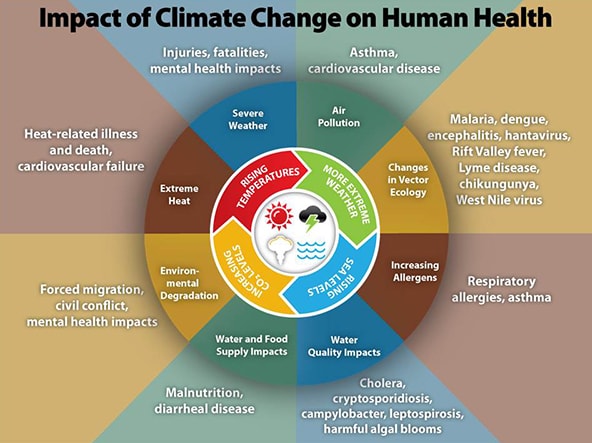Archive for August, 2019
8/12/2000: The Kursk, a Russian nuclear submarine sinks to the bottom of the Barents Sea killing all 118 crew members are later found dead.
Monday, August 12th, 2019https://www.youtube.com/watch?v=3fE8A_u3W2s
CDC: Climate Effects on Health
Monday, August 12th, 2019Climate Effects on Health
The information on health effects has been excerpted from the Third National Climate Assessment’s Health Chapterexternal icon. Additional information regarding the health effects of climate change and references to supporting literature can be found in the Health Chapter at http://www.globalchange.gov/engage/activities-products/NCA3/technical-inputsexternal icon.
Climate change, together with other natural and human-made health stressors, influences human health and disease in numerous ways. Some existing health threats will intensify and new health threats will emerge. Not everyone is equally at risk. Important considerations include age, economic resources, and location.
In the U.S., public health can be affected by disruptions of physical, biological, and ecological systems, including disturbances originating here and elsewhere. The health effects of these disruptions include increased respiratory and cardiovascular disease, injuries and premature deaths related to extreme weather events, changes in the prevalence and geographical distribution of food- and water-borne illnesses and other infectious diseases, and threats to mental health.
CDC and APHA Fact Sheets
- Extreme Rainfall and Drought Can Impact our Health pdf icon[PDF – 98 KB]
- Warmer Water and Flooding Increase the Risk of Illness or Injury pdf icon[PDF – 184 KB]
- Climate Change Decreases the Quality of the Air We Breathe pdf icon[PDF 111 KB]
- Extreme Heat Can Impact Our Health in Many Ways pdf icon[PDF – 108 KB]
- Climate Change Increases the Risk of Vector-Borne Diseases pdf icon[PDF – 112 KB]

Aug. 11, 1965: The Watts Riot begins
Sunday, August 11th, 2019“….The five days of violence left 34 dead, 1,032 injured, nearly 4,000 arrested, and $40 million worth of property destroyed…..”
Tanzania: At least 60 people were killed and scores more wounded in a fuel tanker explosion
Sunday, August 11th, 2019At least 28 people have been killed and more than a million forced from their homes as Typhoon Lekima hit China
Sunday, August 11th, 2019India: At least 95 have been killed by monsoon flooding and hundreds of thousands have been evacuated from their homes
Sunday, August 11th, 2019Rabies: Zero by 30
Saturday, August 10th, 2019Overview

Why eliminate rabies?
An estimated 59 000 people die from rabies each year. That’s one person every nine minutes of every day, 40% of whom are children living in Asia and Africa. As dog bites cause almost all human cases, we can prevent rabies deaths by increasing awareness, vaccinating dogs to prevent the disease at its source and administering life-saving treatment after people have been bitten. We have the vaccines, medicines, tools and technologies to prevent people from dying from dog-mediated rabies. For a relatively low cost it is possible to break the disease cycle and save lives.
A country’s health system benefits from the capacity-building required for rabies surveillance. This core activity strengthens the health system by improving the mechanisms for surveillance of other disease and expanding access to health care. Minimizing duplication and improving efficiencies by pooling resources and developing strong health service networks saves money and makes the most of resources. Countries can maximize the impact of each dollar invested.
Investing in rabies elimination saves lives and strengthens both human and veterinary health systems. A collaborative response, through rabies programmes, contributes to disease prevention and preparedness. This means integrated rabies elimination is a model for One Health collaboration.
In the past, the global response has been fragmented and uncoordinated. We need to break the status quo and come together with a combined will, an achievable goal and a common plan. That combined will was evident in 2015, and the resulting global call to action made it clear that now is the time to act.
A call for action
In 2015, the world called for action by setting a goal of zero human dog-mediated rabies deaths by 2030, worldwide. Now, for the first time, four organizations – the World Health Organizaton (WHO), the World Organisation for Animal Health (OIE), the Food and Agriculture Organization of the United Nations (FAO) and the Global Alliance for Rabies Control (GARC) – have joined forces, as the United Against Rabies collaboration, and are determined to reach this goal.
The United Against Rabies collaboration leverages existing tools and expertise in a coordinated way to empower, engage and enable countries to save human lives from this preventable disease. The global strategic plan puts countries at the centre with renewed international support to act.This country-centric engagement will be flexible and consider different contexts and capacities. Countries will lead efforts, driving the changes needed to reach Zero by 30, empowered by the United Against Rabies collaboration, as they build sustainable institutional capacity and end human deaths from dog-mediated rabies.

WHO reviews the current state of MERS-CoV
Saturday, August 10th, 2019WHO MERS Global Summary and Assessment of Risk
“…..Between 2012 and 30 June 2019, 2449 laboratory confirmed cases of Middle East respiratory syndrome coronavirus (MERS-CoV) infection were reported to WHO, of which 84.0% were reported by the Kingdom of Saudi Arabia.
In total, cases have been reported from 27 countries in the Middle East, North Africa, Europe, the United States of America, and Asia. Males above the age of 60 with an underlying medical conditions, such as diabetes, hypertension and renal failure, are at a higher risk of severe disease, including death. To date, 845 individuals have died (crude CFR 34.5%).
Since the last global update published on 30 June 2018, 219 laboratory-confirmed cases of MERS-CoV from four countries were reported to WHO (204 from Saudi Arabia, 13 from Oman, 1 from the Republic of Korea, and 1 from the United Kingdom), of whom 53 (24.2%) have died. Among these cases, 79.0% were male and the median age was 52 years old (IQR 39-65; range 16-94 years old). The median age is similar to the median age of all cases reported to WHO since 2012 (52 years old, IQR 37-65).
At the time of writing, 49 of the 219 (22.4%) patients were reported as asymptomatic or having mild disease. At least one underlying condition was reported in 145 cases (66.2%) since the last update, including chronic renal failure, heart disease, diabetes mellitus, and hypertension…….”





